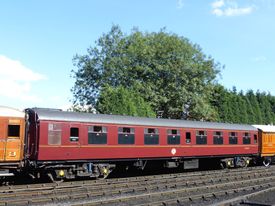BR 25771 Corridor Second
| BR 25771 Corridor Second | |
|---|---|
 BR Corridor Second 25771 | |
| Built By | BR Derby |
| Status | In service |
| Number | M25771 |
| Livery | BR Maroon |
| Other numbers | M18771 |
| History | |
| Built | 1962 |
| Diagram | 146 |
| Lot | 30685 |
| Type | SK |
| TOPS code | AA21 |
| Length | 63ft 5in |
| Weight | 36T (plate shows 37T) |
| Seats | 64 (48 as built) |
| 1986 | Entered preservation |
| 2015 | Overhauled and repainted |
Contents
Contents
Service
25771 was built at Derby in 1962 to Diagram 146 (AA210), Lot 30685. As built it had the 48-seat ‘London Midland Region’ layout and was fitted with Commonwealth bogies, giving a weight of 36 Tons.[3] It entered service as M25771 in the London Midland region in February 1962, being renumbered M18771 in August 1983.[3]
As 18771, it underwent modernisation at the request of sector-owner Network South East. In addition to painting in their livery, the changes included replacement of the 24 volt tungsten bulbs by short fluorescent 110 volt lights. As the 24 volt reading lamps could not be economically modernised, these were removed and a long plain mirror fitted to cover both missing lamps and the earlier mirrors which displayed the "rival" Inter-City double-arrow logo.[4] It was withdrawn from service in October 1990[5].
Preservation
‘18771’ arrived on the SVR on 9 September 1991 from London’s Old Oak Common, courtesy of The 75069 Fund. The carriage was delivered to the SVR by 3440 City of Truro which arrived in steam to attend that year’s Autumn Steam Gala.[6] It entered service still in Network South East striped livery, before being repainted into BR Maroon the following summer.[7] It then re-entered service, still suffering from a wheel flat which was present on arrival and which was not cured until a bogie swap was carried out during a minor overhaul in summer 2003.[8]
By May 2007 it was ‘10 years overdue for a repaint’[9] and was photographed in poor condition for the Railway Heritage Register Carriage Survey.[10] It was then sent to Arley to serve as a classroom during the 1940s event and was trapped there for 18 months following the 2007 Storm Damage. During that time the batteries went flat, the doors swelled up and seats went mouldy. It was eventually retrieved and put into store, being considered possibly surplus to requirements.[9]
In 2015 the need was identified for a 'spare' carriage to replace vehicles from Set N that were due to be withdrawn in turn for overhaul. 25771 was thoroughly overhauled at Kidderminster Carriage Works, having been photographed there in in May 2015 on Facebook, and outshopped in a later variant of BR maroon livery-with maroon ends. Appropriately the interior is typical of latter day Mk 1, being clad with light grey patterned Formica. The 48 seat configuration with which the carriage was originally fitted has been replaced with a 64 seat configuration (the change dating from the Network South East era?) and the carriage data plate edited accordingly (the plate also shows a weight of 37 tons rather than the 36 tons recorded for Lot 30685).
Following this overhaul, 25771 was used as a stand-in for Set N as intended. It has since been available for operational use as required.
See also
References
- ↑ SVR Stock Book 9th edition
- ↑ SVR Charitable Trust
- ↑ 3.0 3.1 Longworth (2013) p.144.
- ↑ SVR News 100
- ↑ Longworth (2013) p.119.
- ↑ SVR News 101
- ↑ SVR News 104
- ↑ SVR News 144
- ↑ 9.0 9.1 SVR News 191
- ↑ [25771 on Railway Heritage Register On-Line
Links
- 25771 on Railway Heritage Register On-Line
- Photos from Richard Herington's post
- Photos from Sharpo's World 2002 and 2005
| ||||||||||||||||||||||||||||||

